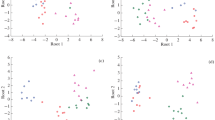Summary
Some fluorimetrical techniques used for the determination of catecholamines have been studied in order to establish their reliability for determinations in organs after infusion of 3,4-dihydroxyphenylalanine (dopa).
In dogs conversion of infused dopa into 3-hydroxytyramine (dopamine) seems to occur in various organs. The role played by heart, liver, spleen, and kidney in the decarboxylation of exogenic 3,4-dihydroxyphenylalanine is difficult to evaluate. Release of 3-hydroxytyramine into the blood stream or uptake of this substance from the blood could have significantly influenced the results.
Zusammenfassung
Einige Methoden zur fluorimetrischen Bestimmung von Katecholaminen wurden im Hinblick auf ihre Zuverlässigkeit für Bestimmungen in Organen nach Infusion von 3,4-Dihydroxyphenylalanin (Dopa) untersucht.
Bei Hunden erfolgt die Decarboxylierung von Dihydroxyphenylalanin zu 3-Hydroxytyramin (Dopamin) offenbar multiloculär. Die Rolle, die das Herz, die Leber, die Milz und die Nieren bei der Decarboxylierung von exogenem 3,4-Dihydroxyphenylalanin spielen, ist schwer abzuschätzen. Abgabe von 3-Hydroxytyramin in die Blutbahn oder Aufnahme aus dem Blutstrom könnten den Gehalt der Organe an 3-Hydroxytyramin nach Infusion von 3,4-Dihydroxyphenylalanin entscheidend beeinflußt haben.
Similar content being viewed by others
References
Bertler, Å., A. Carlsson and Rosengren: A method for the fluorimetric determination of adrenaline and noradrenaline in tissues. Acta physiol. scand. 44, 273–292 (1958).
— and E. Rosengren: (1) “Bound” and “free” catecholamines in the brain. Acta physiol. scand. 50, 113–118 (1960).
Bertler, Å., N.-Å. Hillarp and E. Rosengren: (2) Storage of new-formed catecholamines in the adrenal medulla. Experientia (Basel) 16, 419 (1960).
— (3) Some observations on the synthesis and storage of catecholamines in the adrenaline cells of the suprarenal medulla. Acta physiol. scand. 50, 124–131 (1960).
Bing, R. J., and M. B. Zucker: Formation of pressor amines in kidney. Proc. Soc. exp. Biol. (N. Y.) 46, 343 (1941).
Blaschko, H.: The specific action of l-dopa decarboxylase. J. Physiol. (Lond.) 96, p. 50 (1939).
Carlsson, A., and B. Waldeck: A fluorimetric method for the determination of dopamine (3-hydroxytyramine). Acta physiol. scand. 44, 293–298 (1958).
Crout, R.: Catecholamines in Urine. Standard methods of clinical chemistry, Vol. 3, p. 62–80. New York and London: Acad. Press 1961.
Dennis, D. J., H. Blaschko and A. D. Welch: The conversion of dihydroxyphenylalanine-2-C14 (dopa) to norepinephrine by bovine adrenal medullary homogenates. J. Pharmacol. exp. Ther. 113, 14–15 (1955).
Euler, U. S. v., I. Floding and F. Lishajko: The presence of free and con-. jugated 3,4-dihydroxyphenylacetic acid (dopac) in urine and blood plasma Acta Soc. Med. upsalien. 64, 217–225 (1959).
—, and F. Lishajko: (1) Dopamine in mammalian lung and spleen. Acta physiol. pharmacol. neerl. 6, 295–303 (1957).
— (2) The estimation of catecholamines in urine. Acta physiol. scand. 45, 122 to 132 (1959).
Goodall, Mc. C.: Studies of adrenaline and noradrenaline in mammalian heart and suprarenals. Acta physiol. scand. 24, Suppl. 85 (1951).
—, and N. Kirschner: Biosynthesis of adrenaline and noradrenaline in vitro. J. biol. Chem. 226, 213–221 (1957).
Hagen, P.: Biosynthesis of norepinephrine from 3,4-dihydroxyphenylethylamine (dopamine). J. Pharmacol. exp. Ther. 116, 26 (1956).
Holtz, P.: Dopadecarboxylase. Naturwissenschaften 27, 724–725 (1939).
— u. W. Koepp: Die enzymatische Entstehung von Oxytyramin im Organismus und die physiologische Bedeutung der Decarboxylase. Naunyn-Schmiedeberg's Arch. exp. Path. Pharmak. 200, 356–388 (1942).
— u. K. Lüdtke: Fermentativer Abbau von l-dioxyphenylalanin (Dopa) durch Niere. Naunyn-Schmiedeberg's Arch. exp. Path. Pharmak. 191, 87–118 (1938/39).
Schümann, H. J.: Nachweis von Oxytyramin (Dopamin) in sympathischen Nerven und Ganglien. Naunyn-Schmiedeberg's Arch. exp. Path. Pharmak. 227, 566 bis 573 (1956).
Wegmann, A., K. Kako and A. Chrysohou: Dopa uptake and catecholamine content in heart and spleen. Amer. J. Physiol. 201, 673–676 (1961).
Author information
Authors and Affiliations
Additional information
With 3 Figures in the Text
Rights and permissions
About this article
Cite this article
Wegmann, A. Determination of 3-hydroxytyramine and dopa in various organs of dog after dopa-infusion. Naunyn - Schmiedebergs Arch 246, 184–190 (1963). https://doi.org/10.1007/BF00245004
Received:
Issue Date:
DOI: https://doi.org/10.1007/BF00245004




